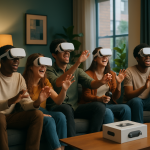
Alright, let’s talk about this wild ride called the rise of AI in film and television. You know, the kind of stuff that makes you wonder if your favorite directors are secretly robots. Kidding, or am I? Anyway, it’s a fascinating development that has dramatically changed how stories are told on the screen. From mind-blowing special effects to eerily realistic CGI characters, AI has taken the production process from zero to warp speed. And, like a true gamer who always has a controller at the ready, let’s jump right into the action-packed realm of artificial intelligence in entertainment.
Welcome to the AI-powered Production Playground
Picture this: you’re sitting in a theater, popcorn in hand, as the lights dim and the trailers start rolling. The next big blockbuster is advertised, boasting effects so lifelike you almost forget you’re watching a movie. A solid 90% of that magic is thanks to AI. Yeah. We’re living in a time when computers can create visuals that leave even the most hardcore cinephiles scratching their heads.
Take the story of “The Lion King” (2019), for example. Not your dad’s VHS version, but this mind-bending photorealistic remake. Directed by Jon Favreau, it was a showcase of AI wizardry. According to a Variety article, Favreau used VR technology to visualize scenes before filming, which is like using cheat codes to unlock superior gameplay. It’s a whole new level of pre-visualization, letting creators roam their digital sets in real-time to plan shots and angles. Talk about stepping up the game!
And then there’s AI in animation. Remember when Pixar’s “Toy Story” came out in 1995? A game-changer, but still a bit rough around the edges by today’s standards. Fast forward to now, and the technology has evolved so much that AI can even handle complex texture and lighting – stuff that used to take animators weeks, if not months. It’s like upgrading from a Nintendo 64 to a PS5 overnight. Mind. Officially. Blown.
CGI Characters and Their AI-driven Charisma
Now, let’s talk about those CGI characters that are so lifelike, you half-expect them to start an Instagram account. AI has leveled up the creation of digital humans, making them emotionally expressive and believable. I remember watching “Rogue One” and thinking, “Wait a second, is that Peter Cushing… alive?” Spoiler alert: it wasn’t. They used AI to resurrect his character, Grand Moff Tarkin, and it was both impressive and a little unnerving.
The process, known as digital resurrection or de-aging, involves feeding a neural network with hours of footage to recreate an actor’s likeness. It’s so detailed, they can even simulate how age affects skin texture and elasticity. This tech isn’t just a one-trick pony, either. It’s being used to create entirely new characters, blending human performance with digital enhancement to bring fantasies to life.
Still skeptical? Well, the geniuses at Weta Digital, the folks responsible for “Avatar,” have been using AI to fine-tune facial animations, making characters more expressive. They developed technology that reads actors’ facial expressions and translates them into the digital realm. It’s like watching a digital puppet master at work, and the result is a level of realism that’s almost unsettlingly genuine.
The Scriptwriting Revolution: AI as the Co-Author
For the longest time, I thought scriptwriting was one of those sacred arts, immune to the tech takeover. Turns out I was wrong big time. AI is now playing a significant role in crafting narratives and dialogues. There’s a nifty program called ScriptBook that analyzes screenplays, predicting box office success and providing feedback on potential script improvements. Writers are basically getting notes from a machine, which is both cool and slightly dystopian.
And, fun fact: “Sunspring,” a short film from 2016, was entirely written by an AI named Benjamin. The script was, well, bizarre to say the least, but it was a monumental moment showing AI’s potential in storytelling. It made me rethink the future of creative writing. Could AI someday pen a screenplay that wins an Oscar? Maybe not today, but never say never.
There’s another layer to this AI-scriptwriting saga: personalized content. Imagine a future where your Netflix account doesn’t just suggest movies but creates them based on your viewing habits. It’s like having a content buffet tailored to your taste buds. And while this might seem like a sci-fi scenario, companies are already tinkering with these algorithms, aiming to predict what audiences will binge next. But there’s a catch AI might churn out stories that are formulaic or lack that human touch. Then again, there are plenty of human writers guilty of that too.
AI and the Human Factor: Creative Companions or Cold Calculators?
Here’s where things get a bit philosophical. Is AI a tool to enhance creativity, or does it risk making humans obsolete in the creative process? I used to think that only a human could capture raw emotion and depth in storytelling. Now, I’m not so sure. AI offers precision and efficiency, freeing up creatives to focus on storytelling rather than the exhaustive grunt work. But it also raises questions about authenticity and creativity’s essence. Can a machine truly understand the nuances of human experience? Probably not, but it can mimic it pretty convincingly.
Some folks argue that AI is just a fancy calculator, crunching data to make production smoother and faster. Yet others see it as a creative partner, opening doors to new forms of expression. Director Alexander Proyas, known for “I, Robot,” once said in an interview with The Hollywood Reporter that AI could be a creative ally, helping filmmakers push boundaries. It’s a bold claim, but maybe he’s onto something. After all, even the most skilled gamers appreciate a good co-op mode.
The Unseen Challenges and Future Possibilities
It’s not all rainbows and laser beams, though. The rise of AI in film and television brings its own set of challenges. Take, for example, ethical concerns about deepfakes. The same tech that brought Tarkin back from the Star Wars grave can be used for less noble purposes, recreating people in ways that are misleading or harmful. The line between fiction and reality gets blurrier, and not in a fun, artsy way.
Further, there’s the question of job displacement. As AI takes on more roles from script analysis to visual effects what happens to the myriad of artists and technicians who once filled those positions? The industry is like an ever-shifting sand dune, where adaptability is key. But it’s a genuine worry for many professionals who see their roles continually evolving. Or disappearing.
Yet, despite these challenges, the potential for AI in entertainment is undeniably alluring. Imagine a future where films are interactive, with storylines that adapt based on audience reactions. It’s like a choose-your-own-adventure book but on steroids. Or, consider AI-driven VR experiences that fully immerse you in a narrative, making you a part of the story. The possibilities are limited only by our imagination and processing power.
In this brave new world of entertainment, AI is both a tool and a muse, reshaping how stories are told and experienced. Whether it will be humanity’s creative partner or its replacement remains to be seen. For now, though, it’s a thrilling time to be a movie lover. So grab your popcorn and buckle up, because this AI-powered cinematic rollercoaster is just getting started.

